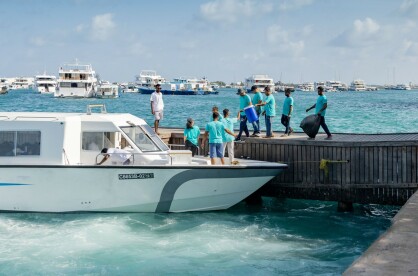In the early 90s, people believed that the structure of the Arctic would not have changed in their life time. Yet, 30 years hence, half of the Arctic sea ice has already melted, and global sea level rise is rampant. Now, another warning bell has been rung.
The polar regions of the world are home to 1.7 percent of the Earth’s water, with most of it being fresh water. This figure may sound tiny numerically, but in reality, the world’s oceans could rise by almost two metres if two major glaciers in the Antarctic region were to melt into the seas. According to the National Snow and Ice Data Center (NSIDC), if all glaciers melted today the seas would rise about 70 metres.
To hammer that point home, it is important to remember this is the sea-level across the globe and not an isolated region. With so much water being stored at the polar caps as ice, the accelerated melting of said ice is most definitely cause for concern. Human-influenced global warming has accelerated the melting of the polar icecaps at such an unprecedented rate that scientists fear it may hit a point of no return within the decade, and the first ‘cracks on the windshield’ have begun to show.
Using the analogy of a car windshield, the most recent news is the accelerated haemorrhaging of the Thwaites Glacier on West Antarctica. Before going further, it is important to understand what a glacier really is, and what makes it different from an ice shelf. Very concisely described on the State of the Planet website, “Glaciers form over land in the poles and on mountaintops. They are large ice masses created by snowfall that has transformed into ice and compressed over the course of many years. Glaciers are known for their ability to move, acting as a slow-moving river. Ice sheets, ice streams, and ice shelves are a few types of glaciers.”
The key point is how glaciers move like a slow river of ice, compressed under literally earth-shattering pressure, reshaping canyons and mountain ranges, and then ending up in the ocean or in lakes. The Thwaites Glacier is no different, yet the rate at which is expels freshwater frozen for thousands of years and removed from the global water-cycle, has increased over the last 30 years. Now, it moves at an incredible 600 metres per year; a rate that is expected to increase even more.
The main buffer that controls the amount of melting of the glacier is the ice shelf upon which it ends. Ice shelves are “permanent floating ice sheets that extend from icy land masses. They form from ice sheets that slowly flow to the sea after breaking off from glaciers or being carved by ice streams. If they don’t melt when they reach the ocean, they can continue to grow into large thick ice masses. They are characteristically flat and featureless. However, they are important because they create a physical barrier around land, slowing the ice sheets’ migration into the ocean. Without them, it is likely that sea levels would rise more quickly.”
The ice shelf that has been buffering the Thwaites Glacier is the metaphorical cracked windshield. Like the glass of a car windshield, a comparably small crack that has appeared on this shelf has been weakening the integral structure, and it is expected to reach a point where the cracks expands exponentially, leading to the collapse of the entire buffer. This would allow the Thwaites Glacier to empty into the ocean at a colossal rate, and also create a chain reaction of glacial melting.
The Thwaites Glacier is, by itself, a buffer preventing the spillage of neighbouring glaciers as well. Once the system collapses, and if all the water in the first glacier is released into the oceans, the sea level would rise by over 65 cm, across the globe. That is more than half a metre in height, and for a nation like the Maldives which lies barely a metre above sea level, this spells absolute annihilation. High tide would sweep over and across entire islands, and entire communities would become permanently displaced.
What has been causing the melting of the ice shelf is, unsurprinsgly, global warming. Scientists have been conducting intensive research on the flow of artic currents, and their discoveries put the breakdown of the ice shelf within a decade. They also point out that the unhindered movement of the Thwaites Glacier into the ocean could empty the entire stockpile of ice within a decade, decimating costal livelihood faster than people could cope. Additionally, if the neighbouring glaciers followed suit, then the sea level is expected to rise two metres from the current point in the years to come.
Maldives is not alone in this predicament; regions such as Shanghai, Florida, and Mumbai would be affected catastrophically as well, reshaping the world’s coastlines within a century or even a lifetime. The reason why such a finding was so late in coming is due to the difficulties faced in conducting any studies in the polar regions due to the subzero temperatures and the mysterious topography of the ice — yet these findings are substantial. Further exploration has been tasked to one of the more ingeniously named vessels, Boaty mcBoatface, a drone submarine, and experts say that even if the cracks are unsettling to observe, this foretelling may not come to pass. If the full understanding that is sorely needed is achieved by further studies, they may find that the ice shelf could be refreezing and melting at a sustainable rate, however, the chances of that are incredibly slim.
Global warming is not just a problem for poorer, low-lying nations around the world. It is a phenomenon with cataclysmic ramifications for the entire human race, with entire crops dying, lakes drying up, and deserts eating up savannahs and woodlands. The warming rate now, if not taken seriously, would hasten even the most aggressive theoretical timelines, drawing the doomsday clock even closer to midnight on coastal nations.
The Maldives, and her people, have nowhere to turn when the water levels wash up on their doorsteps. With the flattest landscape, the fear of losing the solid ground beneath one’s feet is highly probable for the Maldivian archipelago and thus it must constantly be discussed and acted upon so the world at large can be held accountable — and prompted to action. The danger is that it may already be too late.







